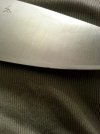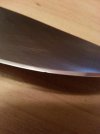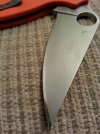Dear Colleagues,
liked
http://www.schmiedecafe.com/forum/attachment.php?attachmentid=83
The following is also a good idea about Edge Stability:
http://www.smt.sandvik.com/en/products/strip-steel/strip-products/knife-steel/knife-steel-knowledge/
You will see there are pictures that show a fine micro structure steel like 12C27 compared to 440C.
you find a PDF download in english as one of my latest works, in steel & knife research ongoing in Germany.
To introduce myself I am knife maker and damascus smith since 1987 in Germany. My profession is graduated engineer in Automotive engineering and Material Science. Meber of the German Knifmakers Guild sinc 1993.
I am also author for the German Book, Messerklingen & Stahl (M&S) Technologische Betrachtung von Messerschneiden (Knife blades and Steel, A technological survey on knife edges © 2002 Wieland Verlag, Bruckmühl, Germany) witch has successfully established a high quality discussion base on scientific research towards knifes and steel. The base of the Book was developed in the early 90’s when I was in my studies.
With this download, you get a little goodie, extracted from the upcoming new book Messerklingen und Stahl, Praxishandbuch der Stähle (Knife blades and Steel; The Practical Handbook of Steels © 2005 Wieland Verlag, Bruckmühl Germany)
What is the download about?
The download shows the so-called “model of the cutting edge” taken from (M&S©2002).
The actual book will show around 50 commonly known tool steels/ -alloys used for knife applications (e.G. ATS 34, 52100, RWL 34, L6, Vascowar, M4,…

an the way to treat them according to this application.
Furthermore, one will see the abilities of the steel used supporting qualities essential for knife application (e.g. edge holding, wear resistance, sharpen ability, cutting ability, cutting edge stability, corrosion resistance,…

, SWOT- Analysis…
The model of the edge provided here, shows 5 selected reference alloys commonly known in the worldwide knife society.
· 1.4125 (440C) Reference for traditional stainless steels
· CPM S90V Reference for modern stainless PM-steels
· Talonite Reference for Chrome Cobalt Alloys
· 1.2510 (O1) Reference for hypereutectic tool steels
· 1.2379 (D2) Reference for 12%-Chrome Cutting Steels
What Do you see?
What you see is the 1000x magnification (means all at the same scale) of the inner structure (microstructure) of this alloys, shown as micrographic pictures, in heat treated condition (Austenizing, Quench, Cryo, Temper in multiple cycles; except Talonite) Etching: Beraha 1.
The white spots, are the so-calles Carbides responsible for the wear resistance in a alloy of this kind (The Teeth), surrounded by the Matrix (Meat) (Martensit, except Talonite)
The sheet is designed to get folded on the edges marked. What you get when you do so, is the model of the edge 1000x magnification in 3D. By using the scale of the angel (Adjust in back light with single print) you can adjust every edge geometry between 15° and 90° edge angle.
This means, having the model in 3D in front of you and assuming there is a local limited load applied from a side force towards the edge (occurs constantly in the normal use of a knife), this force will deflect the edge and in dependence of the load, and the steel can take, the edge will draw back in line or chip locally (wear and loose edge).
The carbides will play a major role in the behavior of the steel in the edge
Since they are very hard and brittle, in a fine cutting edge, carbides are the first point to start with chipping, especially when the are to many in relation to the surrounding (meat) or the carbides are so large, e.g. when they will fit nicely into the full range of sharp and dull limits1)
Note, the large carbides of the alloys shown, will by no means get any significant change in size, during the complete heat treatment cycle (except 01, if hardened at to high temperatures, the carbides will dissolve completely and a mess of retained austenite and coarse brittle Martensit-grain will be there).
What you can do with it now?
Taking into account, that a sharp edge1) is around 1µm on the tip and a dull one1) is around 10µm in width, if a critical load to the edge is applied (wear of the edge), the different alloys behave different at different angles adjusted.
Print the download (use A4 for the print-format), fold at the 3 lines marked and start adjusting the angle.
I am sure this will help, to explain something…
...and hopefully start discussion …
Best regards Roman






